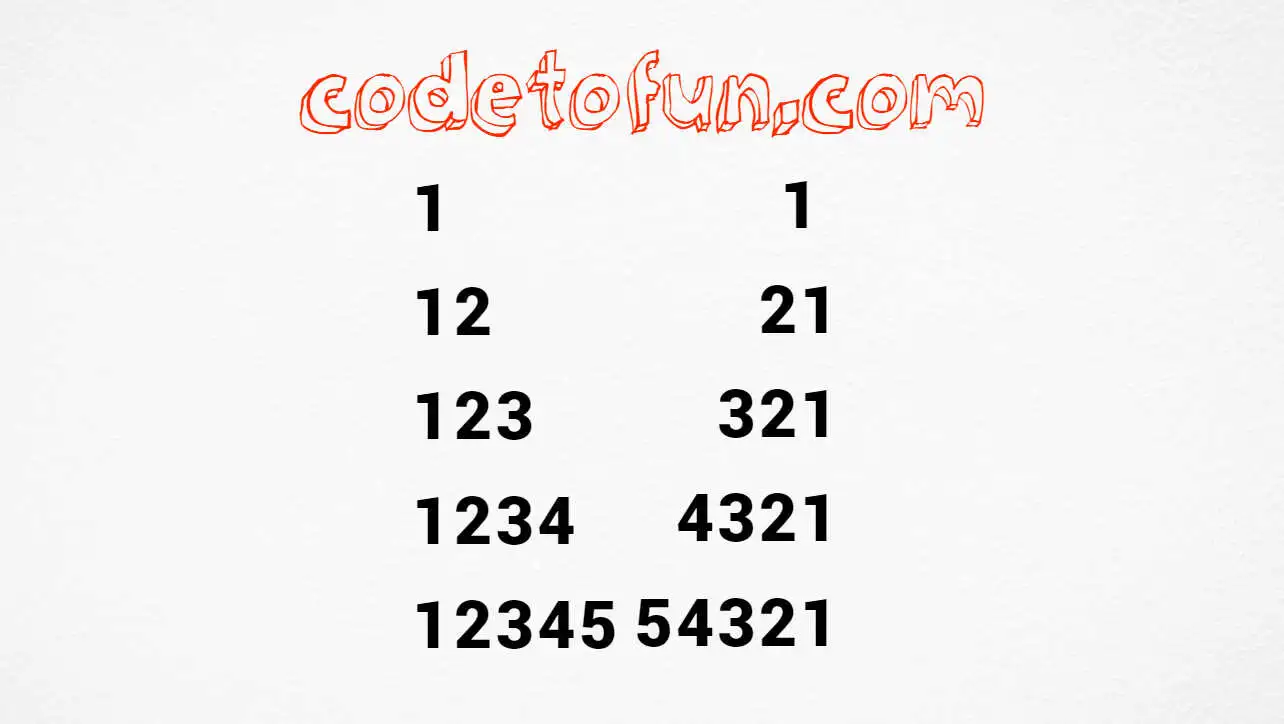
Java Topics
- Java Intro
- Java String Methods
- Java Interview Programs
- Java Star Pattern
- Java Number Pattern
- Number Pattern 1
- Number Pattern 2
- Number Pattern 3
- Number Pattern 4
- Number Pattern 5
- Number Pattern 6
- Number Pattern 7
- Number Pattern 8
- Number Pattern 9
- Number Pattern 10
- Number Pattern 11
- Number Pattern 12
- Number Pattern 13
- Number Pattern 14
- Number Pattern 15
- Number Pattern 16
- Number Pattern 17
- Number Pattern 18
- Number Pattern 19
- Number Pattern 20
- Number Pattern 21
- Number Pattern 22
- Number Pattern 23
- Number Pattern 24
- Number Pattern 25
- Number Pattern 26
- Number Pattern 27
- Number Pattern 28
- Number Pattern 29
- Number Pattern 30
- Number Pattern 31
- Number Pattern 32
- Number Pattern 33
- Number Pattern 34
- Number Pattern 35
- Number Pattern 36
- Number Pattern 37
- Number Pattern 38
- Number Pattern 39
- Number Pattern 40
- Number Pattern 41
- Number Pattern 42
- Number Pattern 43
- Number Pattern 44
- Number Pattern 45
- Number Pattern 46
- Number Pattern 47
- Number Pattern 48
- Number Pattern 49
- Number Pattern 50
- Number Pattern 51
- Number Pattern 52
- Number Pattern 53
- Number Pattern 54
- Number Pattern 55
- Number Pattern 56
- Number Pattern 57
- Number Pattern 58
- Number Pattern 59
- Number Pattern 60
- Number Pattern 61
- Number Pattern 62
- Java Alphabet Pattern
Java Number Pattern 29

Photo Credit to CodeToFun
Java Number Pattern 29
Here`s a program that prints the above number pattern using Java Programming:
public class Demo
{
public static void main(String[] args)
{
int i, j, k;
for(i=1; i<=5; i++)
{
for(j=1; j<=5; j++)
{
if(j <= i)
System.out.print(j);
else
System.out.print(" ");
}
for(k=5; k>=1; k--)
{
if(k > i)
System.out.print(" ");
else
System.out.print(k);
}
System.out.println();
}
}
}💻 Testing the Program
When you run the above program, it will print the following output:
1 1 12 21 123 321 1234 4321 1234554321
🧠 How the Program Works
Let's break down the logic behind the code:
- The program starts with defining a class named Demo.
- The main method is the entry point of the program. It accepts an array of strings args, although in this case, it's not used.
- Three integer variables i, j, and k are declared to control the loops.
- The outer loop (for loop) runs from i = 1 to i <= 5. This loop controls the rows of the pattern.
- Inside the outer loop, there are two nested loops:
- The first nested loop (for loop with variable j) runs from j = 1 to j <= 5. This loop controls the printing of numbers in the left half of each row.
- Inside this loop, there's an if-else condition. If j is less than or equal to i, it prints the value of j. Otherwise, it prints a space.
- The result is that in the left half of the row, the loop prints the numbers 1 to i, followed by spaces.
- The second nested loop (for loop with variable k) runs from k = 5 to k >= 1. This loop controls the printing of numbers in the right half of each row.
- Inside this loop, there's an if-else condition. If k is greater than i, it prints a space. Otherwise, it prints the value of k.
- The result is that in the right half of the row, the loop prints the numbers 5 to i, in decreasing order, followed by spaces.
- After both nested loops have executed, a newline character is printed using System.out.println() to move to the next row.
- The outer loop repeats this process for all rows, incrementing i in each iteration.
💯 Tips for Enhancement:
Explore the versatility of this pattern by adjusting its parameters. Whether you increase or decrease the size, tweak the spacing, or modify the characters used, each change opens up a world of possibilities, allowing you to customize and create your unique visual effects.
✔ Conclusion:
Creating visually appealing patterns is not only a fun endeavour but also a great way to enhance your programming or design skills. We hope this tutorial has inspired you to explore the world of creative coding. Share your creations with us, and let your imagination run wild!
🤗 Closing Call-to-Action:
We'd love to see your unique interpretations of the number pattern. Share your creations in the comments below, and don't hesitate to reach out if you have any questions or suggestions for future tutorials. Happy coding!
👨💻 Join our Community:
Author

For over eight years, I worked as a full-stack web developer. Now, I have chosen my profession as a full-time blogger at codetofun.com.
Buy me a coffee to make codetofun.com free for everyone.
Buy me a CoffeeShare Your Findings to All
Recent Post in Java














If you have any doubts regarding this article (Java Number Pattern 29) please comment here. I will help you immediately.